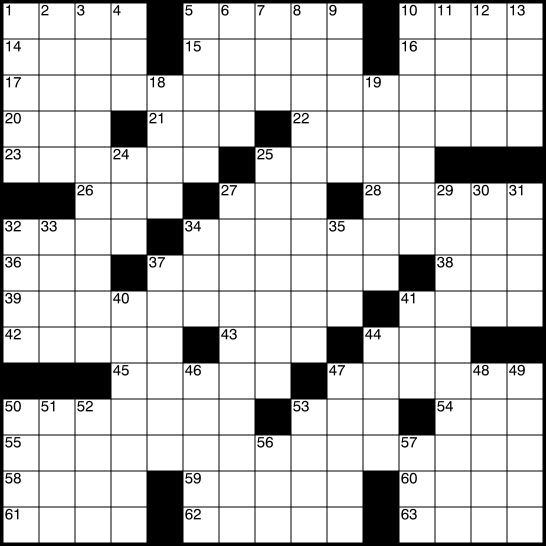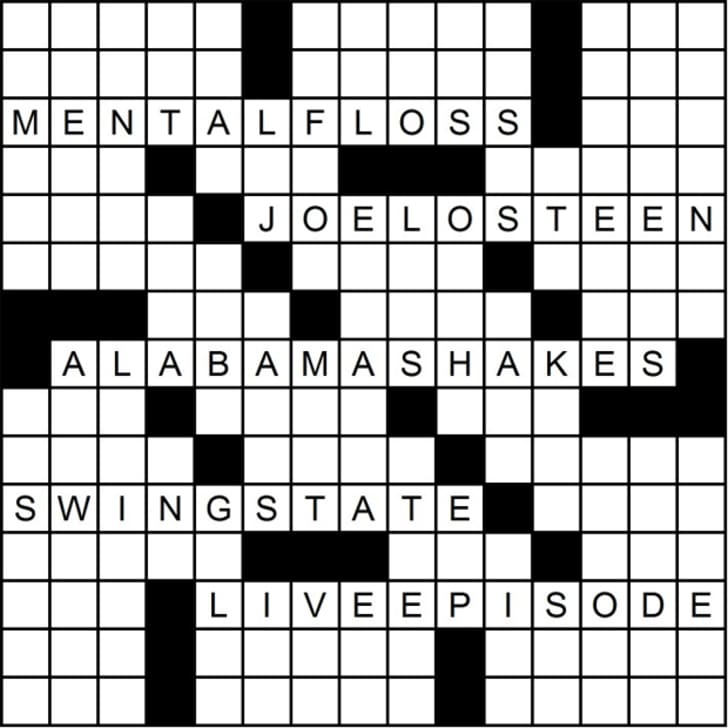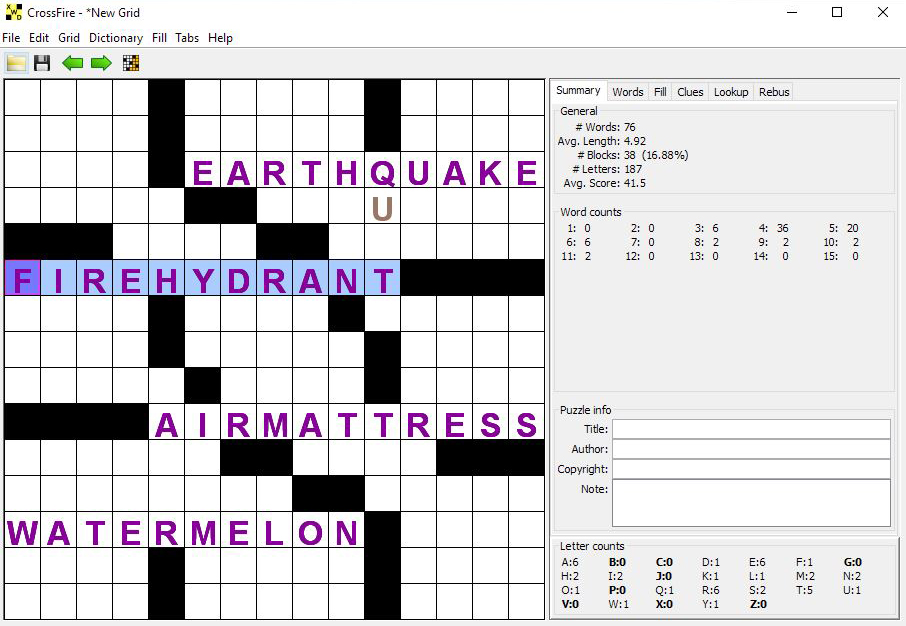Constructing Crosswords: Grid
Constructing Crosswords: Grid
Approaches | Rules | Process | References
Approaches
- Crosswords' basic appeal? “My theory is that it's because of...
- Blank: new empty grid; place theme entries; add blocks (dark squares) as needed
-- approach recommended by NYT, Berry; or if you're creating a distinctive pattern. - Choose: an existing grid pattern from a library, usually based on theme entry lengths
- crosserville.com > Grid Search free account; shows # of 3 letter (and other length) words;
File > Export Puzzle > Across Lite text format(most compatible) in order to import grid into another tool - Crossword Compiler app $
- cruciverb.com $
- xwordinfo.com: Most common Shortz-Era & all-time grid patterns;
Grids with the fewest blocks and most blocks;
Most wide open grids; Answers that float outside the grid;
Connect the dots on grids; Record stacks and some notable 15s
Grids with unchecked squares; Oddly shaped or sized grids;
Unusual symmetry and asymmetry; Grid art; 'Interesting' visual elements;
Grids with no short answers or with very short answers, etc. - OnlineCrosswords.net 12 x 12 - 23 x 23
- ugleh.com > Grid Search enter a grid pattern, search for existing variations currently NYT-only
-

American-style grid by Michael J.
via Wikimedia Commons
Attribution-Share Alike 3.0 UnportedModify (for both Blank and Choose) : after entering theme entries, add/move blocks for esthetics, fill, etc.
- From a distance, many typical grids have subareas segmented by:
- "fingers" from edges, i.e., columns and/or rows of several blocks,
and parallel diagonal "steps" [on right] - Perhaps create grid patterns with embedded shapes
e.g., "Utah": 5 black squares that are shaped like the state.
If you put an 11-letter answer at the center of a 15x15 grid,
you will probably need a Utah at either end. e.g., NYT 3/27/2015 - Welcome to Utahs Newsday; 2/18/2022
- Several tools allow you to flip or transpose a grid, i.e., rotate 90° so that Across entries go Down and vice versa:
Crosserville:Grid > Flip Grid
PuzzleMe:Edit grid & clues > Grid > Transpose grid
Rules
- There are a number of conventions and constraints to consider -- first 3 started in the 1920s:
- Fully-crossed: e.g., each (checked) letter appears in both an Across and Down clue.
- Blocks: ~1/6 of total squares; 15 x 15: max 38; themeless: fewer; Sunday: ~74 (55-84)?
- Grid symmetry: e.g., rotational 180° symmetry (a tool can easily preserve).
- Word length: minimum 3 letters -- no unchecked squares or 2-letter words (a tool can notify).
- 3-letter entries: 15 x 15: < ~20
- Rarely, uncrossed squares or 2-letter words might be permitted, depending on theme & editor's flexibility.
- Word count: 15 x 15: max 78; themeless: max 72.
- Grid layout: e.g., connectivity -- 'all-over interlock'; no islands; exception: quadrupuzzle?
- Avoid narrow (1-2 square wide) 'isthmus' -- fewer crossings makes solving much more challenging.
- There can be exceptions, e.g., Fri, NYT 9/8/2022: "Tetris" discussion
- Grid sizes are odd (15 x 15, 21 x 21) by convention
-- plus maintaining symmetry with the 4 center squares may be more difficult in an even-sized grid? - First theme entry usually appears in third row of a 15 x 15 -- or 4th row if 12-14 letters long.
- Same-length theme entries are placed symmetrically Across, usually;
maybe place entries in Down columns if compatible with the theme, e.g., Fall Into Adventure - Additional shorter theme entries in other direction are possible, but less common due to crossing challenges;
in general, I try to minimize the number of multiple theme crossings by any entries to have more fill options later. - 'Cheater' squares, esp. in corners, are discouraged by editors -- why not make those entries longer?
- Theme entries typically abut left or right puzzle edge.
- Optional: unmatched (odd-length) theme or reveal entry centered in middle row;
usually reveal appears last. - Check Crossword Publication Specs for guidance, e.g.
- NYT: "Crosswords must have black square symmetry,
which typically comes in the form of 180-degree rotational symmetry;
Crosswords must have all-over interlock;
Crosswords must not have unchecked squares
(i.e., all letters must be found in both Across and Down answers);
All answers must be at least 3 letters long;
Black squares should be used in moderation.
Maximum Word Count: 78 words for a 15×15 (72 for a themeless); 140 for a 21×21.
Maximums may be exceeded slightly at the editor’s discretion, if the theme warrants" - LAT: "Max word count is 78; under 43 black squares preferred.
All answer words must interlock throughout the grid, and the grid pattern must be symmetrical.
Rotational symmetry, where the grid looks the same upside down as it does right side up,
is preferred, but right/left symmetry is also acceptable if the theme requires it.
A grid with no symmetry or unusual symmetry will only be considered if the pattern is theme-related" - WSJ: "The word count shouldn’t exceed 78 for a 15-by-15 puzzle
and 140 for a 21-by-21 puzzle (though as many as 144 may be allowed in special cases)" - Univ.: "The maximum word count is 80 for a themed 15x15, 74 for a themeless 15x15, and 146 for a 21x21.
There is no maximum black square count -- just be sure to avoid big chunks of black squares (e.g., a 3x3 block)" - Puzzle stats may be useful:
- crosserville.com > Puzzle Stats
# words, # blocks, avg. word len or # 3 letter words; for sizes: 15 x 15 or 21 x 21;
for publisher: NYT, LAT, WSJ, Univ.; for day of week - xwordinfo.com
many free stats available, e.g., Puzzles with the longest avg. word length;
Words and Letters: Shortz Era & All Time; Grids with the fewest words and most words;
Pangrams and puzzles with the fewest letters used;
Rebus puzzles (symbols or multiple letters in a single square);
Schrödinger puzzles aka quantum crosswords - Cruciverb: Advice on Making 21 x 21 Puzzles
maximum word counts differ depending on the editor. From tough to tougher:
Stan Newman: 146; Mel Rosen: 142; Will Shortz: 140; other: 144
Process
- With theme entries placed, prioritize potential problem areas with few fill and crossing word options.
- Avoid letter patterns with no (or very few) possibilities; pay special attention to words containing J, Q, X, Z
- Use quick / auto fill in construction app -- any complete fill possible, even with some obscure words/crosswordese?
- Re-locate blocks and maybe swap theme entries to improve word choice options and eliminate bottlenecks.
- Modify entry lengths by changing noun and verb endings.
- Flip grid horizontally to shift where crossings occur -- or start over with a different grid.
- Repeat as desired, then proceed to Fill (next section)

References / Examples
- NYT: How to Make a Crossword Puzzle, Part 2: Designing the Grid; Building the framework for a puzzle:
Choosing the Right Tool; Placing the Theme Entries; Those Pesky Letters; Fashioning a Fillable Puzzle; The Perils of AutoFill - Crossword Constructor's Handbook (Berry) Chapter 2: Designing the Grid:
Reviewing the Rules; Making a Grid to Match Your Theme; Placing the theme entries;
What's so special about Across entries? Okay, so what's so great about the third row?
Making the grid "fillable"; Take advantage of the maximum word count; The allure of low word counts;
Avoid creating large white areas; Check answer slots that cross your theme entries;
Examine published grids; Avoid using "cheaters"; Using unusual theme placements;
Putting some theme entries among the Downs; Splitting a theme entry across two slots;
Using left/right grid symmetry; Designing Themeless Grids -

from: mentalfloss.com The Art of Crossword Construction (Johnston): Grid Pattern Conventions:
Grid features; Grid symmetries; Things to avoid in grids; Quiz about unacceptable grids - How Crossword Puzzles Are Really Made Gaffney; MF; 9/10/2014
- How to construct a crossword puzzle for the New York Times
Alex Boisvert, Crossword Nexus; video: 9:44; grid: @4:50; 4/23/2013; - WordPlay documentary: Merl creates grid manually: @0:16:12, @0:19:19
-

from: beekeeperlabs.com (CrossFire) - Examples: OLLI (next subsection)
- CROSSWORDS and YOU: Authoring, Refs: Grids
- Comparison of 75022 published crossword grids
- How USA Today is changing crossword symmetry 11/20/2021
- Hidden Word Puzzles: To Circle or Not to Circle?
earlier reveal for easier puzzles? 7/13/2021
Constructing: Grid: Example: OLLI
Constructing: Grid: Example: OLLI
Try #1
- A custom approach may provide the best results.
- However, it can be a more difficult skill to learn -- practice, trial-and-error, ...
- It's sometimes easier to get started by finding and modifying existing grid patterns from a library.
- 6 theme entries may be overly ambitious; a 15 x 15 puzzle typically aims for 3-4 theme entries
- Staying too attached to favorite entries can lead to tradeoffs,
constraining the number of grid designs and fill words. - However, since we don't plan to publish, let's keep 'em all, and see what happens!
- During theme selection, one set included 4 * 9 letter words
-- instead of 2 * 9 letter, 2 * 10 letter: REBELLION(S), ARAMDILLO(S) - This subsection discusses why that option was rejected.
 Cruciverb: Grid Search:
Cruciverb: Grid Search:
2 * 15-letter, 4 * 9-letter theme entries- 5 possible grids with all 6 theme entries
[on right]; open in browser tab to enlarge - Each grid shows (at upper left)
a word & block count, e.g., 78 / 34 - In all, 2 of the 9-letter entries are Down.
- Down entries are unusual, but they can be allowed;
perhaps ok since there are still 4 Across theme entries?
or if there were clever "Down" related clues: e.g.,
"putting down" a REBELLION or an ARMADILLO? - However, for this set of theme entries, the Across entries don't cross
with the correct letters in the Down entries. - Some grids with two 15-letter entries crossed in center would be amazing, but...
- CROSSPOLLINATOR misses (by 1 letter) 8th letter crossing with HAMLETSOLILOQUY!
 With some manual modifications
With some manual modifications
to a template, a better grid library,
or a completely custom layout,
this theme set might've worked.
Try #2
- Cruciverb: Grid Search: 2 * 15-letter,
2 * 10-letter, 2 * 9-letter entries - 12 grids with all 6 entries [on right]
- "Stacking" of theme entries, e.g., 15-letter entry and 9-letter entry
in adjacent rows, often lead to dead ends. - #04 (on right) shows stacking, with all 6 Across entries
(pink squares are unfillable words; swapping 9-letter entries didn't help)  Although the Down crossings often don't work,
Although the Down crossings often don't work,
the 9-letter Downs partially work in two grids:- #12: OILLEASES x HAMLETSOLILOQUY [yes];
HOIPOLLOI x CROSSPOLLINATOR [no] - #10 (2 crossings!): OILLEASES x HAMLETSOLILOQUY + ARMADILLOS [yes];
HOIPOLLOI x REBELLIONS + CROSSPOLLINATOR [no] 
 #08: grid (shown at right) includes all 6 Across entries, no stacking;
#08: grid (shown at right) includes all 6 Across entries, no stacking;- however, it's 72 / 40 -- 2 black squares more than the preferred max;
and 2 theme entries do not abut left or right edge -- (as discussed under Grid) - "Quick Fill" default result shown on far right
-- a complete fill is possible, though with some unusual/obscure words. 
 Or, manually add blocks, e.g., row of 3 near left top (& right bottom) for total of 32?
Or, manually add blocks, e.g., row of 3 near left top (& right bottom) for total of 32?- 6 fewer 3-letter words --better;
2 more 10-letter (non-theme) entries -- harder to fill - Experiment with placement (swap 9-letter or 10-letter entries),
- or fewer blocks (30 blocks) -- Quick Fill fails.
- Doublecheck puzzle metrics and add 'meta' information.
 e.g., in CrossFire:
e.g., in CrossFire: Summarytab:General: # Words ≤ 78 ?; # Blocks ≤ 38 ?;Word counts: # of 3 letter entries ≤ 20 ?; 1-2-letter entries: 0 ?Puzzle info: enter Title (theme related), Author, Copyright,
Note (to solver; optional) -- useful for later export/print- Hopefully, in Fill (next section), we'll find better word choices.
Constructing: Grid: Example: JCLS
Constructing: Grid: Example: JCLS
 Finding Grids
Finding Grids
- Cruciverb: Grid Search: 4 * 13-letter theme entries
- 18 grids were found
- Word & block count, e.g., 78 / 34 [upper left]
- Generally, avoid grids with word count > 78
or block count > 38 (publisher guidelines)  Prefer shorter words or longer words?
Prefer shorter words or longer words?- Swap theme entries around for better fill?
- Add/remove blocks?
- Which of these (or others) do you prefer?
Selecting Grids
- I selected 4 of those grid patterns that seemed
promising (fillable), including stats/info for each. - before/after images:
theme entries only; complete sample fill. - Cruciverb "grid #"; total word count, block count;
for each word length, its count 
 #8653: 70, 38; 13=4, 10=2, 8=2, 7=5, 6=8, 5=15, 4=26, 3=8
#8653: 70, 38; 13=4, 10=2, 8=2, 7=5, 6=8, 5=15, 4=26, 3=8- This particular grid has a 7-letter entry in the center
-- when LIBRARY was added (for the course logo image),
with theme order: 1. ONCE...; 2. TALK...; 3. SHARE...; 4. TELL...,
the result was"Unfillable Grid";
however, fill is possible in 2 (of 24) arrangements of theme entries;
assess quality of fill for 1, 2, 4, 3 and/or 1, 4, 3, 2? 
 #4378: 72, 37; 13=4, 7=16, 6=4, 5=8, 4=28, 3=12
#4378: 72, 37; 13=4, 7=16, 6=4, 5=8, 4=28, 3=12
 #5140: 74, 37; 13=4, 8=4, 7=6, 6=4, 5=18, 4=22, 3=16
#5140: 74, 37; 13=4, 8=4, 7=6, 6=4, 5=18, 4=22, 3=16
 #6104: 74, 38; 13=4, 8=4, 7=4, 6=6, 5=15, 4=28, 3=13
#6104: 74, 38; 13=4, 8=4, 7=4, 6=6, 5=15, 4=28, 3=13- Which of these empty grids should we use later when starting our own fill?